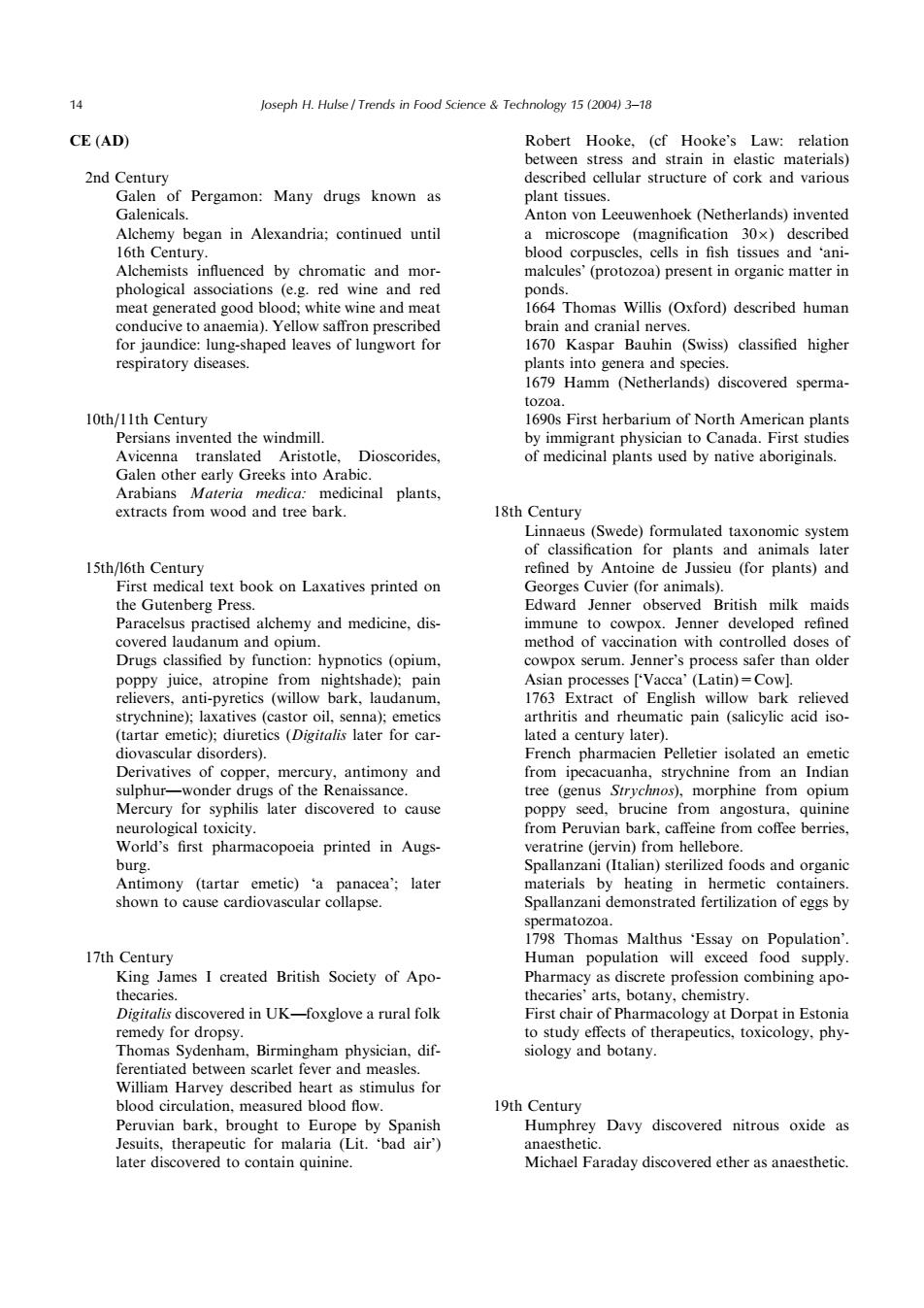正在加载图片...

Joseph H.Hulse Trends in Food Science Technology 15(2004)3-18 CE(AD) Robert Hooke,(cf Hooke's Law:relation between stress and strain in elastic materials) 2nd Century described cellular structure of cork and various Galen of Pergamon:Many drugs known as plant tissues. Galenicals Anton von Leeuwenhoek (Netherlands)invented Alchemy began in Alexandria:continued until a microscope (magnification 30x)described 16th Century. blood corpuscles,cells in fish tissues and 'ani- Alchemists influenced by chromatic and mor- malcules'(protozoa)present in organic matter in phological associations (e.g.red wine and red ponds. meat generated good blood;white wine and meat 1664 Thomas Willis (Oxford)described human conducive to anaemia).Yellow saffron prescribed brain and cranial nerves. for jaundice:lung-shaped leaves of lungwort for 1670 Kaspar Bauhin (Swiss)classified higher respiratory diseases. plants into genera and species. 1679 Hamm (Netherlands)discovered sperma- tozoa. 10th/11th Century 1690s First herbarium of North American plants Persians invented the windmill. by immigrant physician to Canada.First studies Avicenna translated Aristotle,Dioscorides, of medicinal plants used by native aboriginals. Galen other early Greeks into Arabic. Arabians Materia medica:medicinal plants, extracts from wood and tree bark. 18th Century Linnaeus (Swede)formulated taxonomic system of classification for plants and animals later 15th/16th Century refined by Antoine de Jussieu (for plants)and First medical text book on Laxatives printed on Georges Cuvier(for animals). the Gutenberg Press. Edward Jenner observed British milk maids Paracelsus practised alchemy and medicine,dis- immune to cowpox.Jenner developed refined covered laudanum and opium. method of vaccination with controlled doses of Drugs classified by function:hypnotics (opium, cowpox serum.Jenner's process safer than older poppy juice,atropine from nightshade);pain Asian processes ['Vacca'(Latin)=Cowl. relievers,anti-pyretics (willow bark,laudanum, 1763 Extract of English willow bark relieved strychnine);laxatives(castor oil,senna);emetics arthritis and rheumatic pain (salicylic acid iso- (tartar emetic):diuretics (Digitalis later for car- lated a century later). diovascular disorders). French pharmacien Pelletier isolated an emetic Derivatives of copper,mercury,antimony and from ipecacuanha,strychnine from an Indian sulphur-wonder drugs of the Renaissance. tree (genus Strychnos),morphine from opium Mercury for syphilis later discovered to cause poppy seed,brucine from angostura,quinine neurological toxicity. from Peruvian bark,caffeine from coffee berries, World's first pharmacopoeia printed in Augs- veratrine (jervin)from hellebore. burg. Spallanzani (Italian)sterilized foods and organic Antimony (tartar emetic)'a panacea';later materials by heating in hermetic containers. shown to cause cardiovascular collapse. Spallanzani demonstrated fertilization of eggs by spermatozoa. 1798 Thomas Malthus 'Essay on Population' 17th Century Human population will exceed food supply. King James I created British Society of Apo- Pharmacy as discrete profession combining apo- thecaries. thecaries'arts,botany,chemistry. Digitalis discovered in UK-foxglove a rural folk First chair of Pharmacology at Dorpat in Estonia remedy for dropsy to study effects of therapeutics,toxicology,phy- Thomas Sydenham,Birmingham physician,dif- siology and botany. ferentiated between scarlet fever and measles. William Harvey described heart as stimulus for blood circulation.measured blood flow. 19th Century Peruvian bark,brought to Europe by Spanish Humphrey Davy discovered nitrous oxide as Jesuits,therapeutic for malaria (Lit.bad air') anaesthetic. later discovered to contain quinine. Michael Faraday discovered ether as anaesthetic.CE (AD) 2nd Century Galen of Pergamon: Many drugs known as Galenicals. Alchemy began in Alexandria; continued until 16th Century. Alchemists influenced by chromatic and morphological associations (e.g. red wine and red meat generated good blood; white wine and meat conducive to anaemia). Yellow saffron prescribed for jaundice: lung-shaped leaves of lungwort for respiratory diseases. 10th/11th Century Persians invented the windmill. Avicenna translated Aristotle, Dioscorides, Galen other early Greeks into Arabic. Arabians Materia medica: medicinal plants, extracts from wood and tree bark. 15th/l6th Century First medical text book on Laxatives printed on the Gutenberg Press. Paracelsus practised alchemy and medicine, discovered laudanum and opium. Drugs classified by function: hypnotics (opium, poppy juice, atropine from nightshade); pain relievers, anti-pyretics (willow bark, laudanum, strychnine); laxatives (castor oil, senna); emetics (tartar emetic); diuretics (Digitalis later for cardiovascular disorders). Derivatives of copper, mercury, antimony and sulphur—wonder drugs of the Renaissance. Mercury for syphilis later discovered to cause neurological toxicity. World’s first pharmacopoeia printed in Augsburg. Antimony (tartar emetic) ‘a panacea’; later shown to cause cardiovascular collapse. 17th Century King James I created British Society of Apothecaries. Digitalis discovered in UK—foxglove a rural folk remedy for dropsy. Thomas Sydenham, Birmingham physician, differentiated between scarlet fever and measles. William Harvey described heart as stimulus for blood circulation, measured blood flow. Peruvian bark, brought to Europe by Spanish Jesuits, therapeutic for malaria (Lit. ‘bad air’) later discovered to contain quinine. Robert Hooke, (cf Hooke’s Law: relation between stress and strain in elastic materials) described cellular structure of cork and various plant tissues. Anton von Leeuwenhoek (Netherlands) invented a microscope (magnification 30) described blood corpuscles, cells in fish tissues and ‘animalcules’ (protozoa) present in organic matter in ponds. 1664 Thomas Willis (Oxford) described human brain and cranial nerves. 1670 Kaspar Bauhin (Swiss) classified higher plants into genera and species. 1679 Hamm (Netherlands) discovered spermatozoa. 1690s First herbarium of North American plants by immigrant physician to Canada. First studies of medicinal plants used by native aboriginals. 18th Century Linnaeus (Swede) formulated taxonomic system of classification for plants and animals later refined by Antoine de Jussieu (for plants) and Georges Cuvier (for animals). Edward Jenner observed British milk maids immune to cowpox. Jenner developed refined method of vaccination with controlled doses of cowpox serum. Jenner’s process safer than older Asian processes [‘Vacca’ (Latin)=Cow]. 1763 Extract of English willow bark relieved arthritis and rheumatic pain (salicylic acid isolated a century later). French pharmacien Pelletier isolated an emetic from ipecacuanha, strychnine from an Indian tree (genus Strychnos), morphine from opium poppy seed, brucine from angostura, quinine from Peruvian bark, caffeine from coffee berries, veratrine (jervin) from hellebore. Spallanzani (Italian) sterilized foods and organic materials by heating in hermetic containers. Spallanzani demonstrated fertilization of eggs by spermatozoa. 1798 Thomas Malthus ‘Essay on Population’. Human population will exceed food supply. Pharmacy as discrete profession combining apothecaries’ arts, botany, chemistry. First chair of Pharmacology at Dorpat in Estonia to study effects of therapeutics, toxicology, physiology and botany. 19th Century Humphrey Davy discovered nitrous oxide as anaesthetic. Michael Faraday discovered ether as anaesthetic. 14 Joseph H. Hulse / Trends in Food Science & Technology 15 (2004) 3–18�